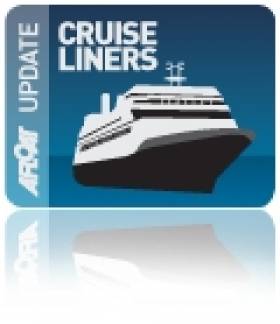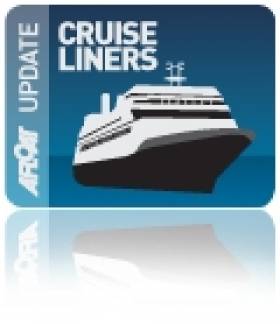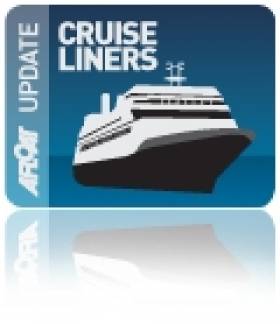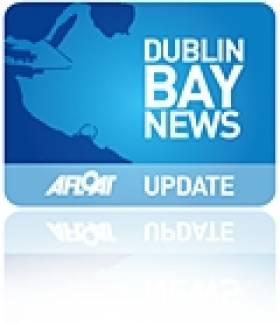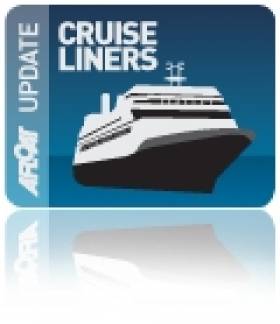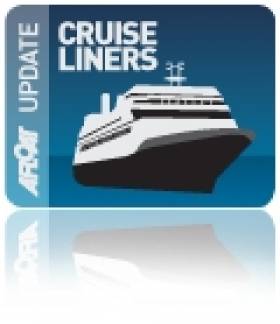Displaying items by tag: Cruise Liners
#FerrytoCruisePlans – With increasingly mixed reaction on Dun Laoghaire Harbour's plans for a proposed new €18m cruise berth facility, what will happen to the existing albeit redundant Stena HSS fast-ferry linkspan berth, writes Jehan Ashmore.
Afloat.ie has inquired with Stena Line to confirm the status of the unique ro-ro port infrastructure on St. Michaels Wharf. The ro-ro linkspan berth was exclusively designed to serve the High Speed Seaservice (HSS) car-carrying and freight craft catamaran, Stena Explorer. She made her debut on the Dun Laoghaire-Holyhead route in April 1996.
It is now almost seven months ago since the route to Holyhead closed with the final sailing departing Dun Laoghaire Harbour on 9 September. Stena say as part of their agreement with Dun Laoghaire Harbour Company, they will have to remove the linkspan and that they are making plans to do so with the assistance of Stena Metall and Stena Teknik.
The end of the Ireland-Wales route, came as no surprise as there was widespread speculation in recent years over the service's ability to be viable. It was in February when Stena announced the permanent closure of the route and that there would be no service in 2015.
This led to Stena pulling out of Dun Laoghaire Harbour and concentrate instead out of neighbouring Dublin Port on the existing route to Holyhead and launch of Stena Superfast X alongside Stena Adventurer.
When the HSS Stena Explorer entered service almost two decades ago, the Dun Laoghaire linkspan was custom built for the fast-ferry. Incidently, she was the first HSS launched and would become the last of the trio of HSS 1500 series to remain serving Stena Line.
When berthing at the linkspan, the HSS Stena Explorer did not require mooring ropes alongside St. Michaels Wharf, but instead satellite technology guided the 19,638 tonnes fast-ferry to the linkspan. Shore-based arms would clamp at the craft-stern upon arrival and released for the departing sailing on the 52-nautical mile crossing to Anglesey.
An Irish Sea serving sister, HSS Stena Voyager which served Belfast-Stranrear (since closed) had on occasions appeared on the central corridor route to cover for 'Explorer's dry-docking. As for the third sister, HSS Stena Discovery, she served on the southern North Sea on the Harwich-Hook van Holland route.
Currently, a public consultation process on the Dun Laoghaire Harbour Company's cruise-berth proposal is underway with an expiry date for submissions / observations next Monday 13 April (for further details click HERE).
The consultation is in advance of an expected planning application by DLHC on behalf of the Dun Laoghaire Cruise Stakeholder Group to An Board Pleanala.
If the plan goes ahead the cruise facility would incorporate use of the former Stena ferry terminal on St. Michaels Wharf which was built in the 60's and originally featured a pair of ro-ro ferry berths.
The former Stena terminal as previously reported would also be transformed as the ferry vehicle marshalling area would be turned into coach, taxi and mini-bus parking use.
In addition the project would involve constructing a new boardwalk overlooking the adjoining 820-boat marina.
SOS: Over Luxury Cruise Passengers Who 'Won't Stay In Town'
#TradersFears-Cruise passengers will bypass Dun Laoghaire for Dublin's delights, that's what traders fear so that the new €18m berth will be a waste of money, writes The Independent.ie
Nearly 5,000 passengers and crew will disembark next month from a 20-storey floating pleasure palace as the first of 18 super cruisers and four smaller cruise ships sail into the port of Dun Laoghaire, Dublin, for the summer season.
It should be good news, right? A procession of well-heeled visitors coming into the seaside borough that has been hit harder than most by the crash?
But many locals say it won't mean a thing to them.
As previously reported on Afloat.ie, among the record 22 cruise callers will be the anchorage call of the Splendida on May 11, with 1,313 crew and 3,900 tourists.
Each passenger will have paid up to €3,369 to be pampered with 11 nights of wining and fine dining aboard the 333-metre cruise vessel, plying the route from Hamburg to Southampton via Dublin and Scotland.
It boosts all-inclusive access to four restaurants, a jazz bar, ice cream parlour and chocolate shop among its amenities, but passengers and crew are also each expected to spend on average €70 each time they disembark.
Proponents of a plan to turn Dun Laoghaire into a major port of call for luxury cruising ships claim the estimated 100,000 passengers and crew aboard 22 cruise ships berthing at the port this summer will inject an estimated €7m into the local economy - with approximately one-third spent in Dun Laoghaire during a typical 12-hour stopover.
But as the Dun Laoghaire Cruise Stakeholder Group, (DLSG) comprised of the local council and business improvement association and the Dun Laoghaire Harbour Company, begins a two-week public consultation process tomorrow (Afloat.ie adds that the process has already begun since last Monday, 30 March) on re-developing the historical harbour to accommodate super cruise ships, local opinion is sharply divided.
"It's madness," Peter Kerrigan, a local businessman and chair of the Dun Laoghaire/Rathdown Ratepayers' Association, said bluntly of the €18m plan to build a new berth and quay capable of accommodating super cruise ships up to 340 metres long.
Super cruisers currently have to berth off-shore with passengers getting to and from dry land via a shuttle boat.
The plan also includes transforming the now-defunct Stena Line ferry marshalling area into coach, taxi and mini-bus parking and building a new boardwalk overlooking the marina.
For more on this story, click here.
Woman Dies Boarding Queen Elizabeth Cruise Liner
#CruiseLiners - Telegraph Travel reports that a passenger on the Queen Elizabeth has died after an incident while boarding the ocean liner as it was anchored off Cambodia.
The female passenger, who has not been named, was boarding the Cunard cruise ship from a tender off Sihanoukville in Cambodia's south-west when she ended up in the water.
Despite the tender's crew quick efforts to rescue her from the water, she later died in the ship's medical centre.
The newest addition to Cunard's cruise liner fleet, and the second largest after the Queen Mary 2, was last seen in these waters when she berthed off Dun Laoghaire in August 2013.
The Telegraph has much more on the story HERE.
#HSStoCruiseScene - Had Stena Line retained running HSS Stena Explorer this year on the Dun Laoghaire-Holyhead route, this would have been her 20th year and with sailings scheduled to have begun last week, writes Jehan Ashmore.
However, the final chapter for Stena Line on this historic Ireland-Wales route came to an end with the official announcement in February to close the Dun Laoghaire-Holyhead route permanently in 2015 as previously reported on Afloat.ie.
The development saw the historic 170 year route cease having its origins dating to 1835. Stena instead concentrated all operations on its other Dublin Bay service using those from Dublin Port on the existing route to Holyhead.
For more on the end of the Dun Laoghaire ferry-era, a photo of the HSS Stena Explorer (published in Ships Monthly) as she departs Dun Laoghaire Harbour for the final time on the 9th September with the return leg to Holyhead.
HSS Stena Explorer made her debut in 1999 as the first of a trio of 1500 series. The revolutionary catamaran car and vehicle carrying fast-ferry craft directly replacement the last conventional ferry on the route, the Stena Adventurer. Not to be confused with the current Stena Adventurer serving the Dublin Port-Holyhead route and joined earlier this month by Stena Superfast X.
Notably, no other vessel except the HSS Stena Explorer can use the custom built linkspan structures that lay idle in Dun Laoghaire Harbour and Holyhead Port, as the HSS was exclusively guided to these specialist structures using satellite positioning technology. Remarkably, this did not requiring berthing in the traditional way, as 'arms' clamped the stern without the need for ropes, dockers and related fees.
So what beckons the future ferry service? as previously reported on Afloat.ie, the invitation from Dun Laoghaire Harbour Company for a new ferry operator to run a seasonal-only service resulted in seven interested parties. According to DLHC, a berth has been made available and should a service resume, it would not be until 2016.
Further updates on this development will be made on 'Ferry News', noting the new dynamics following yesterday's launch by the Dun Laoghaire Harbour Company's Public Consultation Process over the proposed €18m cruise ship jetty and associated berth quay facility.
For full details of the proposals and the public consulation process visit: http://dlharbour.ie/projects/cruise-berth-consultation/
The proposed port infrastructure at Dun Laoghaire would jut out into the harbour beyond the marina's eastern breakwater that adjoins the former Stena HSS berth linkspan.
While across Dublin Bay, a €30m cruise terminal is also proposed in Dublin Port but closer to the capital 'Docklands' at the East-Link Bridge. Both proposed facilities would be capable of handling the world's largest cruiseships.
Businesses to Fight Dun Laoghaire Port Cruise Plans
#CruiseConcerns- An objection from businesses in Dun Laoghaire are to be lodged over the proposed development of the harbour into a cruise ship facility, reports the Herald.ie.
The Dun Laoghaire Rathdown Ratepayers' Association will make a submission outlining concerns about the Harbour Company's €15m plan to overhaul the harbour.
It will bring no economic benefit to the area and will upset the harbour, according to association chairman Peter Kerrigan.
"Passengers on cruise ships won't spend money in the town - they'll go out to Glendalough or into the city. All of their food and accommodation is on board," he said.
"With the ferries we had tourists coming in. They stayed locally and spent money."
The ferry routes were the "bread and butter" of the seaside town, Mr Kerrigan added.
Stena Line called time last month on its Dun Laoghaire-Holyhead route.
For more on the newspapers story click, here.
As previously reported on Afloat.ie, the Dun Laoghaire Harbour Company unveiled Cruise Berth Plans details of the proposed €18m plan to facilitate some of the world's biggest cruise liners inside the harbour walls.
As of today (30 March), the DLHC has opened a two week public consultation process in advance of an expected planning application to An Board Pleanala for the project.
In advance of the submission of the planning application, the Dun Laoghaire Stakeholder Group is anxious to hear the views of harbour stakeholders and the general public.
Observations or comments can be submitted to the Dun Laoghaire Harbour Company, anytime up to 5pm on Friday, 13th April 2015.
For full details of the proposals and the public consulation process visit: http://dlharbour.ie/projects/cruise-berth-consultation/
#CruiseBelfast – Belfast Harbour is to play host to almost 115,000 cruise visitors in 2015, with the first cruiseship Voyager having arrived earlier this morning from Iceland, writes Jehan Ashmore.
The Voyages of Discovery 540 passenger cruiseship opened the season having called to Reykjavik for passengers to witness a total eclipse of the sun. Voyager has 270 cabins in which 87% have ocean views and 35 spacious suites, of those 30 feature balconies.
The 15,396 tonnes ship which is operating 'turnaround' cruises from Portsmouth International Port has recently been awarded the Cruise Critic UK Editors' Picks Award for Best Itineraries. This is where Voyager's call today will offer cruise-goers to visit Northern Ireland's many sights and attractions not just in Belfast but throughout Ulster.
Among the cruise lines calling to the city, are Princess Cruises, Celebrity, All Leisure, Silversea, Majestic, Fred Olsen Cruise Line, Saga Cruises.
A notable caller will be the return of Royal Princess, the biggest ever cruiseship to have visited Beflast port when the Princess Cruises giant last year made her debut call in September.
The giant 141,000 tonnes ship is firstly to call this May and the 3,560 passenger cruiseship is to make several repeat calls scheduled throughout the season. She has 1,780 cabins in which 1,438 with balcony (all outside staterooms feature a balcony).
For further details, visit the Belfast Harbour Cruise caller list, click here.
16-Year Sentence For Costa Concordia Captain
#CostaConcordia - The disgraced former captain of the Costa Concordia, the cruise ship that capsized off the Italian coast three years ago, has been convicted on multiple counts of manslaughter and sentenced to 16 years imprisonment, as the Guardian reports.
Thirty-two people died in the disaster that ensued after the cruise liner struck a sandbank near Isola del Giglio off Tuscany on the night of 13 January 2012.
And only last summer was the ship refloated as part of a pioneering international salvage operation.
One Irish couple were among the more than 4,000 passengers and crew who were evacuated from the vessel amid much criticism of Captain Francesco Schettino's behaviour on the night.
While the Costa Concordia's crew were later presented with the prestigious Lloyd's Lost Seafarer of the Year award for their "courage and professionalism" in response to the disaster, Schettino was branded 'Captain Coward' after evidence emerged that he abandoned ship before hundreds of passengers had been rescued.
In mid 2013, five other officers from the ship received jail terms as part of their plea bargains with the court over their connection with the incident, but an offer of a similar deal by Schettino's lawyers was refused.
However, Italy's mandatory suspension of sentences under two years means that none of the officers were likely to spend any jail time – and the complicated appeals system means that it could also be many years before Schettino sees the inside of a prison cell.
The Guardian has more on the story HERE.
What Next For Dun Laoghaire After Stena Departure?
#DunLaoghaire - With the end of Stena's ferry service between Dun Laoghaire and Holyhead confirmed earlier this week, The Irish Times' Lorna Siggins gauges the mood in the south Dublin port that aims to transition from a commercial focus to a more diverse leisure hub.
Described as "the worst-kept secret on this coastline" by harbour user and dinghy sail trainer Alistair Rumball, Stena's decision to pull out of Dun Laoghaire is being seen as good news for the harbour company's master plan, with its emphasis on enticing cruise traffic, tourism and related facilities.
Among these are the planned diaspora centre, and the 'urban beach' project for the East Pier that was green-lit by planners late last year but is currently under appeal.
However, local TD Richard Boyd-Barrett argues that the move only opens the way for "back-door privatisation” of the harbour. And even our own WM Nixon wondered earlier this year about the scale of the master plan's ambition, and whether Dun Laoghaire has lost the plot.
The Irish Times has much more on the story HERE.
Hurtigruten Appoint New Country Director UK & Ireland
#Hurtigruten – Hurtigruten, operators of a fleet of 12 ships on the Norwegian coastal voyages have appointment Cecilia Abert as Country Director for the UK & Ireland with her position to take place in mid-February.
"Cecilia comes with a wealth of experience that will enable us to substantially grow our business in this key strategic market place" commented Hurtigruten's Chief Commercial Officer, Magnus Wrahme.
In her capacity as Country Director, Ms. Abert will oversee the sales, marketing and brand building of the Hurtigruten product offering the Norwegian Coastal Voyages, the expedition voyages to Antarctica, Greenland and Arctic's Svalbard, as well as land-based polar adventures. They also operate in European waters in the spring and autumn.
"I am so excited to take the Hurtigruten brand to the next level and continue to build increased awareness for this highly differentiated business with its unique 122 year history. I believe there are tremendous opportunities within the growing exploration travel and cruise markets to offer products which consumers are asking for. Whether nature lovers or adventure seekers, Hurtigruten offers something for everyone", stated Abert.
Cecilia brings an extensive track record in travel sales and marketing to her new role at Hurtigruten. Prior to joining the team, she spent over 11 years with Regent Seven Seas Cruises (formerly Radisson). Most recently, she was Senior Sales & Marketing Director overseeing all commercial initiatives in UK & Europe.
Dun Laoghaire Prepares for 88,000 Cruise Liner Visitors This Summer
#cruiseliners – Dún Laoghaire Harbour is preparing for a bumper season of cruise–liner visits to the south Dublin Bay port. The biggest caller will be the first arrival in May (calling on May 15th and again on the 21st) and also at the end of August when the cruise ship Splendid arrives with a massive 3,900 passengers and 1346 crew onboard.
If it is assumed that every ship is full to capacity and every passenger goes ashore then Dun Laoghaire can expect an influx of some 63,237 waterborne tourists over the course of the 2015 summer season.
If you add in ships crew numbers this figure is boosted by over 25,000 bringing the potential visitor tot to 88,282. A welcome boost!
Read the full 2015 Dun Laoghaire cruise–liner calendar below:
11/05/15 – Splendida – 3900 passengers/1313 crew
12/05/15 – Royal Princess – 3600 passengers/1346 crew
20/05/15 – Queen Mary 2 – 3000 passengers / 1328 crew
21/05/15 – Splendida – 3900 passengers / 1313 crew
24/05/15 – Royal Princess – 3600 passengers / 1346 crew
05/06/15 – Royal Princess – 3600 passengers / 1346 crew
14/06/15 – Celebrity Silhouette – 2886 passengers / 1525 crew
19/06/15 – Island Sky – 116 passengers / 66 crew
26/06/15 – Star Legend – 208 passengers / 164 crew
29/06/15 – Royal Princess – 3600 passengers / 1346 crew
29/06/15 – Wind Surf – 312 passengers / 312 crew
12/07/15 – Star Legend – 208 passengers / 164 crew
14/07/15 – Brittania – 3647 passengers / 1350 crew
17/07/15 – Royal Princess – 3600 passengers / 1346 crew
23/07/15 – Royal Princess – 3600 passengers / 1346 crew
23/07/15 – Celebrity Silhouette – 3145 passengers / 1525 crew
04/08/15 – Royal Princess – 3600 passengers / 1346 crew
15/08/15 – Celebrity Silhouette – 3145 passengers / 1525 crew
16/08/15 – Royal Princess – 3600 passengers / 1346 crew
28/08/15 – Royal Princess – 3600 passengers / 1346 crew
29/08/15 – Splendida – 3900 passengers / 1346 crew
18/09/15 – Mein Schiff 4 – 2500 passengers / 1000 crew




























